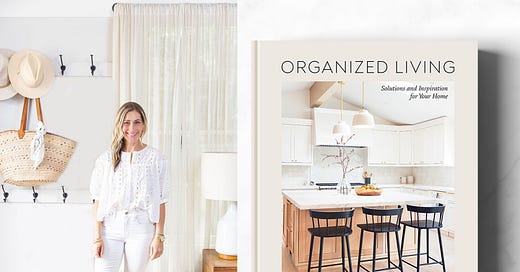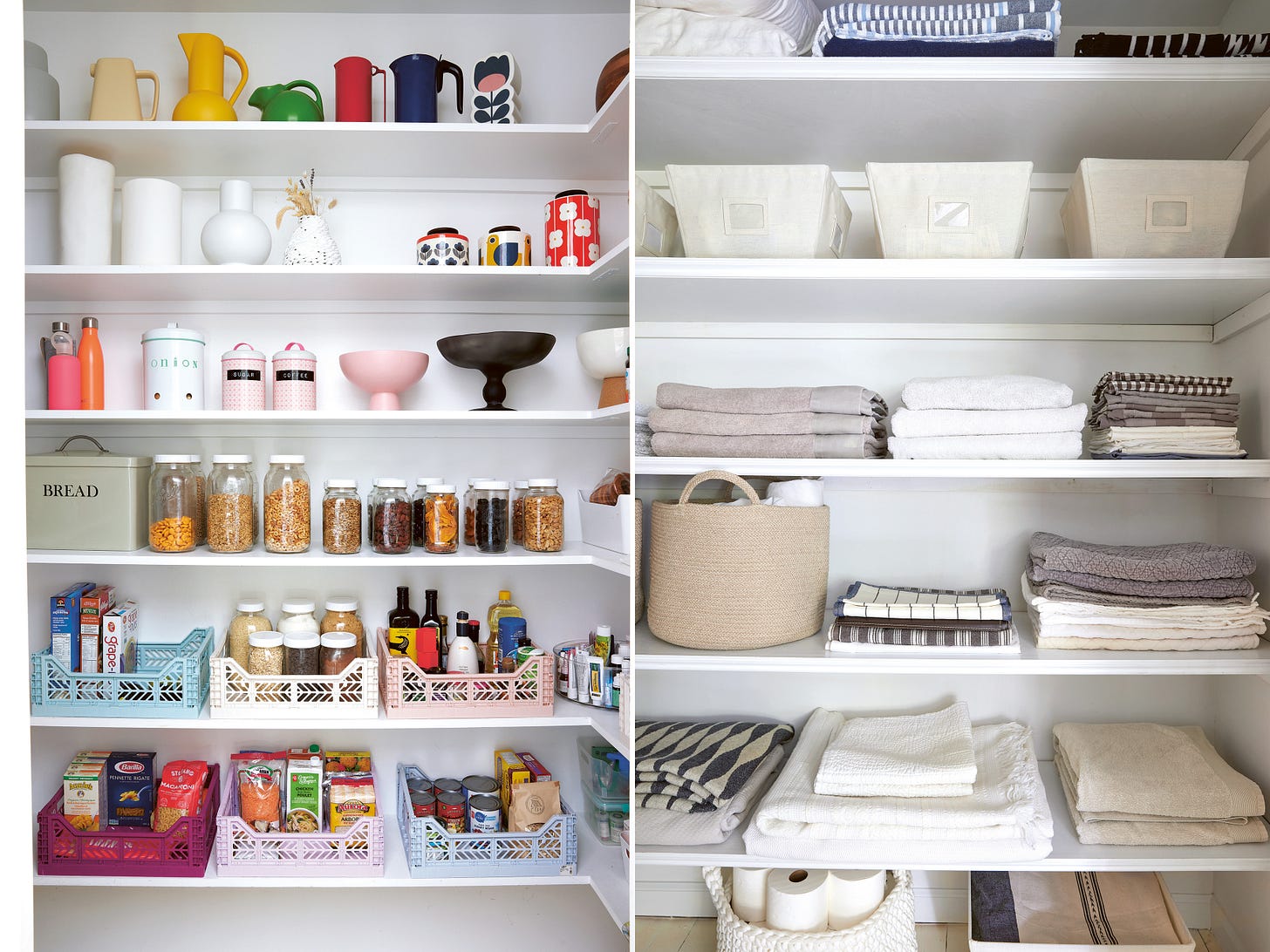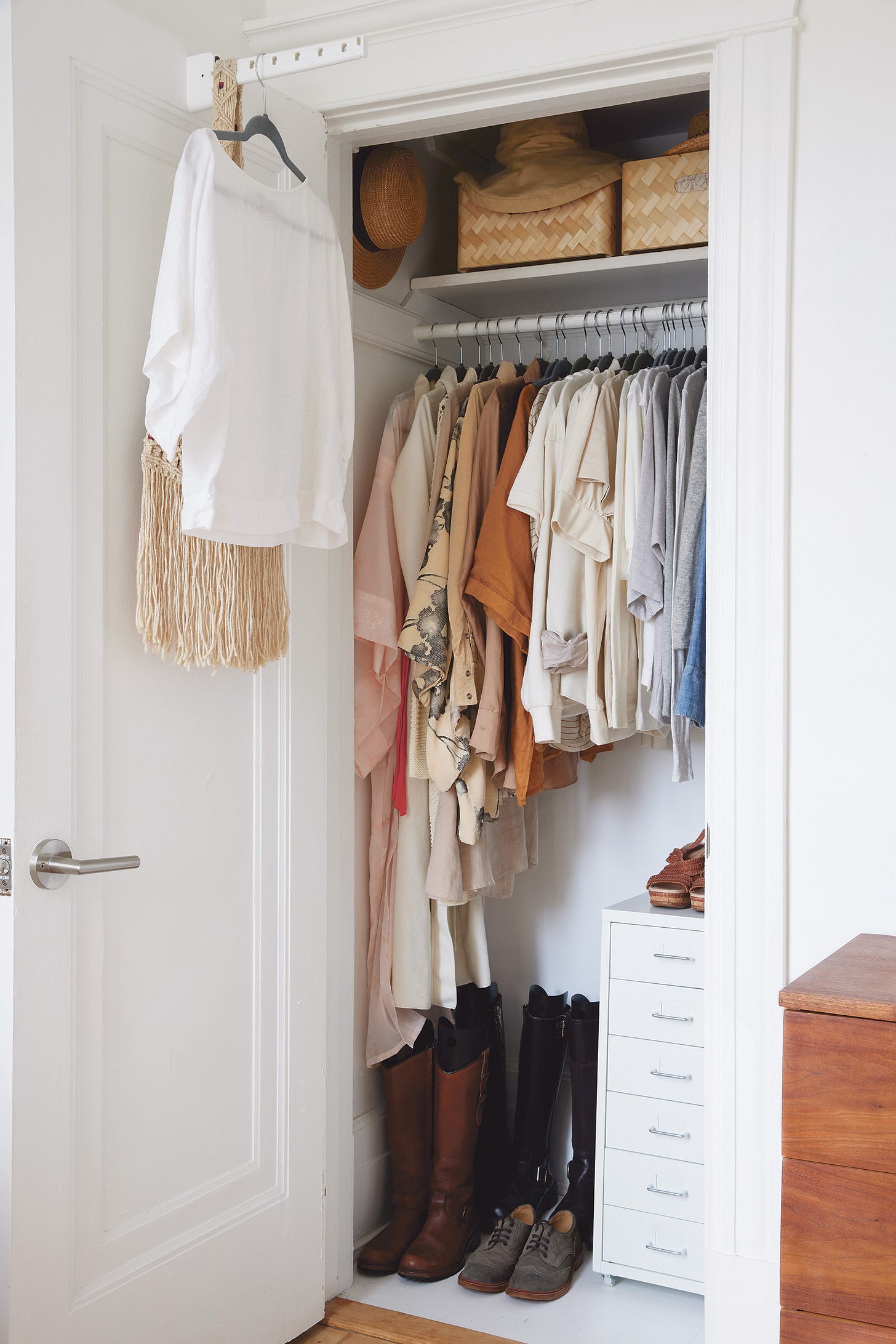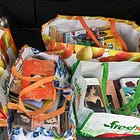7 little lessons for organized living
Shira Gill's new book is jam-packed with small-space inspiration
Ten years ago I would never have identified myself as a minimalist. My pulse quickens at the sight of an “estate sale” sign, I luxuriate in a ramble through the flea market, and well, let’s not talk about books, shall we? But back in 2016 while I was interviewing professional organizer
for an article, she introduced me to a new definition of minimalism.To Shira, “minimalism” means just the right amount of something—stripping away the excess to get to what is essential (and maybe, if you’re me, hundreds of books are essential?). I was on assignment for work, but our conversation made me look at my own home and my possessions with new eyes: What was truly essential? I'm grateful to Shira for helping me identify as, if not a minimalist, someone who is minimalist-ish.
I’m cheering Shira on as she debuts her sophomore book on home organizing, Organized Living Amazon / Bookshop. Shira’s first book Minimalista Amazon / Bookshop was all about her personal system of decluttering and organizing. Shira’s own aesthetic is airy and Scandi-inspired (which I am 100-percent on board with), but her new book sets out to prove that being organized doesn’t look just one way.
Featuring the homes of 25 professional organizers, which range from big to tiny and spare to pleasingly full, the book is a study in all the different ways a home can be organized. It’s also peppered with useful advice that will help anyone living in a small space. So, I pulled out 7 ideas from Organized Living that I plan to borrow:
🎙️ LISTEN! Paid subscribers can listen to this newsletter as an audio edition here.
1. Create a transitional place for clutter
Two different organizers suggest storing an empty basket in a central place to gather all the debris that tends to pile up in a day (organizer Tinka Markham Piper calls it a “crap collector” while Holly Blakey calls it a “transitional basket”), but whatever you call it, it should live in a central place, where you can easily stash all the items that need to bre returned to their proper homes.
2. Style your hard-working spaces
Teasing out the lessons from Tinka’s home, Shira writes, “Add pops of color and joyful touches to the utilitarian areas of your home, like the laundry room, entry, and food pantry.” While later on in the book, we see wardrobe organizer Jean Gordon’s linen closet where baskets and canvas bins hide T.P. and household essentials, like sunscreen, bug spray, and first-aid supplies. Seeing the photos (below) I appreciate how a little styling can go a long way to make utilitarian spaces more joyful, and in my experience, when something is beautiful, you’re more likely to maintain it.
In case you missed it: There’s a full tour of Tinka’s home from Shira’s book up on Domino.com
3. Go truly minimal with bed linens
With no linen closet, Ashley Murphy of NEAT Method owns just one set of sheets per bed. Shira writes, “Sheets are washed and immediately returned to each bed—no storage (or folding) necessary.” We’ve been unintentionally doing this since we got a bigger bed (and haven’t yet settled on our dream linens), and I can report it also keeps you honest about letting laundry pile up.
4. Shop secondhand for organizing supplies
I already do this, but it’s a welcome reminder when zerowaste organizer Julien Febvre advises readers to “check your local secondhand shops, Buy Nothing community groups, flea markets, and estate sales to find treasures (often for a steal!).” I got most of my clamp-top glass jars at thrift stores and have several vintage woven trays.
5. Photograph favorite outfits
Here’s a simple-but-so-smart wardrobe planning tip: Shira writes that Jean Gordon suggests “snapping photos of favorite outfit formulas and making an album for visual styling reminders.” I’ve heard of documenting outfits before, but I love the next level step of making themed albums: Date night, WFH, evening events, etc.
6. Try this tactic for unfinished projects
I loved Claudia Torre’s method for dealing with those dreaded never-finished projects: First give them a deadline for completion, then put a sticky note with the date on the physical project itself. “If you haven’t finished a project by the deadline, then commit to tossing, donating, or giving it away,” Shira writes. I’m not sure this would work for me, but I’m willing to give it a try!
7. Store leftover containers inside the fridge
I don’t know why this one feels like such a big “aha,” but Shira tells us that Wiebke Liu, the founder of BlissHaus “stores her glass food storage containers in the fridge (even when clean and empty!) to save space.” It’s no different that storing pans in the oven, but I never would have thought to try it. Examining the photos it looks like Wiebke uses Bormioli Rocco’s Frigoverre containers.
Related posts from the archive:
+ The most-clicked link from last week:
Food stylist Romilly Newman’s home tour on Clever.
3 More Things
Terremoto’s landscape designs for Sea Ranch, which were presented at the Garden Futures Summit. Photograph by Caitlin Atikinson
Imagining the garden of the future
I’m still buzzing from attending the Garden Futures Summit hosted by the Garden Conservancy last Friday. If you’re a garden person (and even if you’re not!), I hope you’ll to read my report from the summit. Gardens really can be agents for positive change in the age of climate crisis. I also adored
of the Avant Gardener newsletter’s advice to a reader who wants to turn her yard into “an integrated landscape utilizing native plants.” It’s so actionable and accessible.An interview with the minimalist mom
In case you missed it: Diane Boden invited me to chat on her Minimalist Moms Podcast inspired by my post on why editing our closets is so hard (linked above). Diane recently launched her own Substack
I can’t wait to read more.Examining the diet culture-home connection
‘s essay Tiny Women, Big Houses, gave me lots to think about (as Virginia’s writing so often does!). It had me also contemplating about the diet culture underlying a minimalist aesthetic. I was pleased to see this recent story on Clever that addresses the need for well-designed furniture for bodies of all sizes.One last thing: Swooning over this Big Sur-inspired SoHo loft from the AD archive. (h/t to
for surfacing it)










Thanks for sharing these tips! I'm not sure that I'm exactly a minimalist (actually, I know I'm not), but I am trending more in that direction all the time.
Number 7 🤯